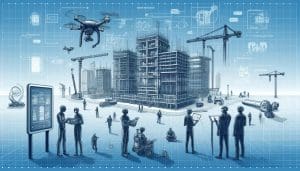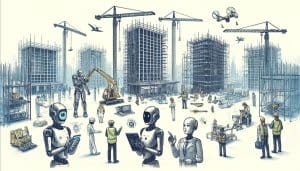With AI developing at a rapid rate, it promises to bring dramatic changes to the construction industry. James Bowles, founder of Freeform 4D, outlines some of what to expect and how best to prepare for the future
What will be the impact of AI in construction?
It’s hard to predict exactly what the impacts of AI will be, and when we’ll feel them. But one thing is clear, things are going to change dramatically. Recent progress with AI tools has been extremely impressive, and if the cycles of improvement and investment continue at this pace, there’ll be fast-growing use of AI in our daily work.
In a moment, I’ll jump forward 10 years and try and describe a typical day on a construction project. But first, some quick terms:
Co-Pilots: These advanced tools assist human workers by automating repetitive tasks, providing real-time data analysis and offering intelligent recommendations. They act as expert assistants, continuously learning and improving to support tasks efficiently.
Agents: Autonomous systems capable of making decisions, completing complex tasks, managing workflows and optimising processes without continuous human intervention. These agents can operate independently to enhance project management and execution.
AI: In this article, we’ll use the term “AI” to encompass the tools, systems, platforms, machine learning, computer vision, large language models and all other technologies related to AI. Forgive the simplification of this complex and diverse ecosystem.
 The construction project team in 2034
The construction project team in 2034
In the near future, our project teams will include AI agents and co-pilots working alongside us. This could take many forms but may start with specialist AIs performing work in support of traditional roles.
Think of an AI QS, AI planner or AI safety manager. They’ll attend our Teams calls, be always-on and may even have avatars, unique voices, memory and a consistent presence. We’ll think of them as extra team members and, over time, may blur the line between human and machine.
Imagine a typical working day. You’ll attend a project call with a fully functioning co-pilot. This co-pilot will take notes, suggest actions in real-time during the call and generally support you in various ways. Perhaps it presents you drawings, documents and other reference materials during the call to improve your understanding of the point being discussed.
After the call, it will summarise actions, draft response emails, suggest next steps and contact anyone you need to follow up. While working through any actions it’ll be there in support, with a perfect recall of the meeting as a reference.
As the day progresses, you’ll trust your co-pilot to interact with various other team members (and their co-pilots and other agents), read and reply to various requests on channels such as voice, email and project notifications.
Later in the day, perhaps you need to drop into some deep work and need to be undisturbed. Your co-pilot will be tuned to this and suggests that it takes over any incoming requests and filters only essential communications.
It’ll then drop into the task with you, opening files, rearranging your desktop set up to perform the work, presenting relevant information and helping you plan and work through the task.
Since the co-pilot and agents can be task – and role – specific, they’ll be able to go into the details of the work with you, making your time more productive and improving the work you’re doing.
They’ll be able to hold in memory everything relevant on the project – drawings, specifications, contracts, as well as all regulations, standards and local conditions. After working with project teams for long enough, they’ll build up their skills and experience and be of great value to project teams.
In addition to these personal and project-level AIs, there will be various other AIs in our daily lives, including organisational level AIs who’ll oversee projects and support with compliance, resources, governance and project oversight.
Quite how we’ll experience these AIs is an interesting question. Perhaps with a range of unique avatars and “personalities” we’ll quickly accept them into our daily lives as colleagues and companions. We may render them as unique entities, and they’ll interact with our teams as synthetic team members.
 AI in construction: Benefits and barriers
AI in construction: Benefits and barriers
Having AIs blended into our project teams will mean teams are more aligned, collaborative and supported with real-time analytics, greatly improving project management, and leading to faster, safer, cost-certain projects.
Organisations that integrate AI first will see productivity gains that are not possible by any other means. Competitive pressure will drive adoption. This abundant and available synthetic intelligence will enhance every aspect of project delivery. Possibly over a very short time frame.
Individuals who develop skills in AI, or just understand how to use AI tools, will be at a significant advantage.
There are certainly barriers to widespread adoption: ethical concerns, security risks, biases, technical challenges and various trust issues. These are significant challenges and will need careful and deliberate strategies to overcome.
Specialist AI teams will manage this process and have the task of maximising benefits and adoption, while addressing technical and cultural barriers.
How should individuals prepare?
Test, learn and get involved. Start using available tools such as OpenAI’s ChatGPT and Google’s Gemini. Experiment with these tools for daily tasks like writing emails, building reports, or summarising documents.
Take this further with background reading on AI and participate in forums, webinars, industry groups and conferences.
How should organisations prepare?
Invest in AI training to equip teams with the necessary skills and awareness.
The construction industry is well placed to pilot AI tools since most of our work is based on projects. Specific projects can be selected and these pilots can be used to demonstrate AI’s value and refine strategies before full-scale implementation.
Foster a culture of innovation by encouraging and recognising employees’ exploration of AI solutions.
The future of AI in construction
The future of AI in construction is coming fast, no doubt bringing radical changes. Staying informed about AI developments and familiarising ourselves with current tools will help us navigate this transformation effectively.
If you’d like to connect with others interested in this topic and learn more, please contact me.

 AI in construction: Benefits and barriers
AI in construction: Benefits and barriers